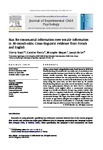Bias for consonantal information over vocalic information in 30-month-olds: cross-linguistic evidence from French and English.
| dc.contributor.author | Nazzi, T | |
| dc.contributor.author | Floccia, Caroline | |
| dc.contributor.author | Moquet, B | |
| dc.contributor.author | Butler, J | |
| dc.date.accessioned | 2017-09-18T13:28:31Z | |
| dc.date.available | 2017-09-18T13:28:31Z | |
| dc.date.issued | 2009-04-01 | |
| dc.identifier.issn | 0022-0965 | |
| dc.identifier.issn | 1096-0457 | |
| dc.identifier.uri | http://hdl.handle.net/10026.1/9960 | |
| dc.description.abstract |
Using a name-based categorization task, Nazzi found in 2005 that French-learning 20-month-olds can make use of one-feature consonantal contrasts between new labels but fail to do so with one-feature vocalic contrasts. This asymmetry was interpreted as developmental evidence for the proposal that consonants play a more important role than vowels at the lexical level. In the current study using the same task, we first show that by 30 months French-learning infants can make use of one-feature vocalic contrasts (e.g., /pize/-/pyze/). Second, we show that in a situation where infants must neglect either a consonantal one-feature change or a vocalic one-feature change (e.g., match a /pide/ with either a /tide/ or a /pyde/), both French- and English-learning 30-month-olds choose to neglect the vocalic change rather than the consonantal change. We argue that these results suggest that by 30 months of age, infants still give less weight to vocalic information than to consonantal information in a lexically related task even though they are able to process fine vocalic information. | |
| dc.format.extent | 522-537 | |
| dc.format.medium | Print-Electronic | |
| dc.language | eng | |
| dc.language.iso | eng | |
| dc.publisher | Elsevier BV | |
| dc.subject | Child, Preschool | |
| dc.subject | Cross-Cultural Comparison | |
| dc.subject | Female | |
| dc.subject | France | |
| dc.subject | Great Britain | |
| dc.subject | Humans | |
| dc.subject | Linguistics | |
| dc.subject | Male | |
| dc.subject | Phonetics | |
| dc.subject | Voice | |
| dc.title | Bias for consonantal information over vocalic information in 30-month-olds: cross-linguistic evidence from French and English. | |
| dc.type | journal-article | |
| dc.type | Article | |
| plymouth.author-url | http://www.ncbi.nlm.nih.gov/pubmed/18572185 | |
| plymouth.issue | 4 | |
| plymouth.volume | 102 | |
| plymouth.publication-status | Published | |
| plymouth.journal | J Exp Child Psychol | |
| dc.identifier.doi | 10.1016/j.jecp.2008.05.003 | |
| plymouth.organisational-group | /Plymouth | |
| plymouth.organisational-group | /Plymouth/Faculty of Health | |
| plymouth.organisational-group | /Plymouth/Faculty of Health/School of Psychology | |
| plymouth.organisational-group | /Plymouth/REF 2021 Researchers by UoA | |
| plymouth.organisational-group | /Plymouth/REF 2021 Researchers by UoA/UoA04 Psychology, Psychiatry and Neuroscience | |
| plymouth.organisational-group | /Plymouth/REF 2021 Researchers by UoA/UoA04 Psychology, Psychiatry and Neuroscience/UoA04 REF peer reviewers | |
| plymouth.organisational-group | /Plymouth/Research Groups | |
| plymouth.organisational-group | /Plymouth/Research Groups/Centre for Brain, Cognition and Behaviour (CBCB) | |
| plymouth.organisational-group | /Plymouth/Research Groups/Centre for Brain, Cognition and Behaviour (CBCB)/Cognition | |
| plymouth.organisational-group | /Plymouth/Research Groups/Plymouth Institute of Health and Care Research (PIHR) | |
| plymouth.organisational-group | /Plymouth/Users by role | |
| plymouth.organisational-group | /Plymouth/Users by role/Academics | |
| dc.publisher.place | United States | |
| dcterms.dateAccepted | 2008-05-13 | |
| dc.identifier.eissn | 1096-0457 | |
| dc.rights.embargoperiod | No embargo | |
| rioxxterms.versionofrecord | 10.1016/j.jecp.2008.05.003 | |
| rioxxterms.licenseref.uri | http://www.rioxx.net/licenses/all-rights-reserved | |
| rioxxterms.type | Journal Article/Review |


